Charlie Rose is tired. At least, that’s what his Twitter handle says these days. And no, we’re not talking about the disgraced American television journalist who was fired in the wake of #MeToo. We’re talking about another Charlie Rose, the brilliant animator from MootroidXproductions who has spent the last 2-years working on a Pokemon vs Godzilla stop motion animation. The incredible project, titled “Pexachu VS Godzilla (Pokémon/Godzilla stop motion),” is an epic battle sequence of an unusually muscular Pikachu Pokémon battling a gang of Godzillas.
Pexachu VS Godzilla was posted to YouTube on December 26, 2020, as almost a late Christmas gift to the Internet. It started to gain some momentum between Christmas and New Year’s, but then exploded after Reddit users discovered it. The official Reddit Twitter account even shared a clip from Pexachu Pokemon VS Godzilla on the morning of January 5, 2021, and the video quickly blew up on social media.
The team here at MethodShop was one of the first publishers to amplify the “Pexachu VS Godzilla” video and immediately asked to talk to Rose. He graciously granted our request, and we are proud to share this interview with you.
Interview with Charlie Rose from @MooXProductions about his brilliant #stopmotion animation Pexachu VS Godzilla ... #StopMotionLife #StopMotionAnimation #Godzilla #Pokemon Share on XYou must be beyond proud. “Pexachu vs Godzilla” is a brilliant work of art. Did it really take you two full years to complete? How many hours a day did you typically spend working on the project?
I am very proud, thank you! The first shot was animated almost exactly two years before I uploaded the final product. But I mainly worked on it between other projects and college classes. Sometimes I’d work on it for a month straight, or sometimes for just a week or two with several months in between.
My animation sessions usually last somewhere from one to three hours. I would also work on editing and special effects during my free time between classes. In total, I estimate I spent about 6-10 consecutive months on this.
What was the most difficult sequence or effect in Pexachu vs Godzilla?
By far, it was the sequence in which Pexachu grabs Godzilla by the tail and swings him around in a circle before launching him into the stratosphere. That scene defeated me so completely that I took my longest break from the film while trying to work out exactly how I’d pull it off.
I shot and cut several different takes using a variety of methods, such as suspending Godzilla with strings, or running a thick strand of aluminum wire through his hollow body and connecting to the ground.
Originally, I had intended it to be one continuous shot, but eventually I decided that it would only work if I broke it up into a series of shorter shots. But finally, I decided to specifically arrange some of the buildings surrounding Pexachu so that most of Godzilla’s mass could rest on top of them.
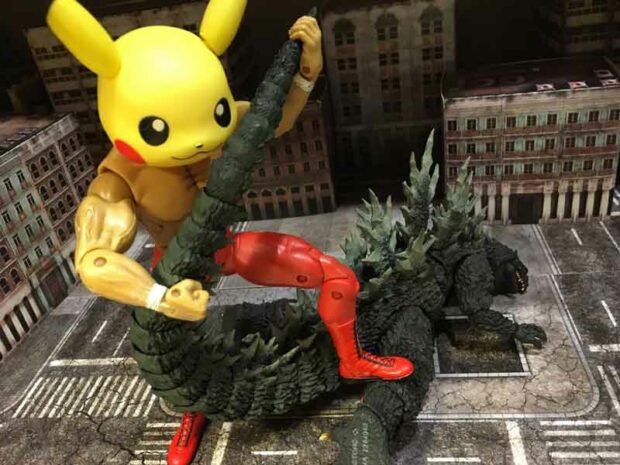
The Pexachu action figure also wasn’t strong enough to support a larger Godzilla figure – one of his wrist joints even snapped in half at one point – so I had to buy a second body for him. I glued the joints of the first figure into a specific tail-spinning pose so that he wouldn’t fall over from all that weight.
There are two versions of the action figure body – one official, one off-brand – so it’s actually possible to see a subtle change in Pexachu’s skin tone before and after that scene.
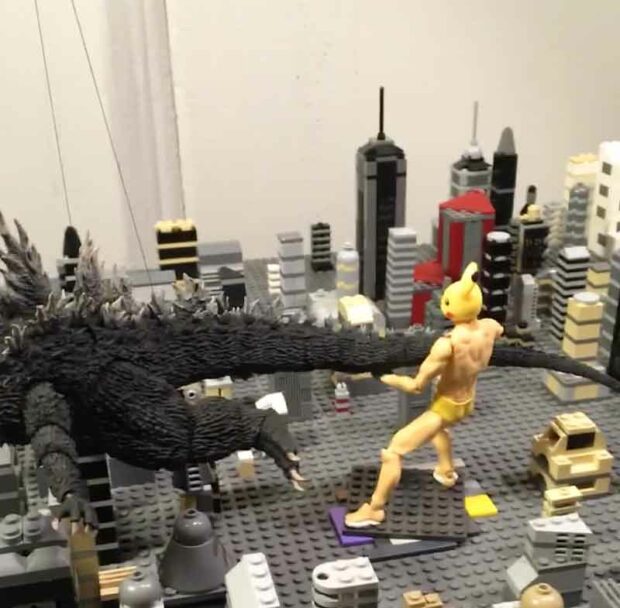
Tell us about your creative process. How did you get the idea to create a Pokemon vs Godzilla stop motion video and where did you start? Storyboards? Test animations?
I don’t know exactly where the idea came from. All I can really say is that one day, an image just appeared in my head and I knew I had to make him real. As for why I decided to make him fight Godzilla, well – what else was he supposed to do?
In addition to the two iterations of Pexachu used in the film, there was an early version using a WWE wrestler action figure and a larger Pikachu head, but the articulation was lacking. It resembled a man in a giant mask rather than an inexplicably shredded Pikachu. I did some simple animation with that version. If you’re curious, there’s an older video on my channel called Pexachu’s Rampage that I made for a class assignment.
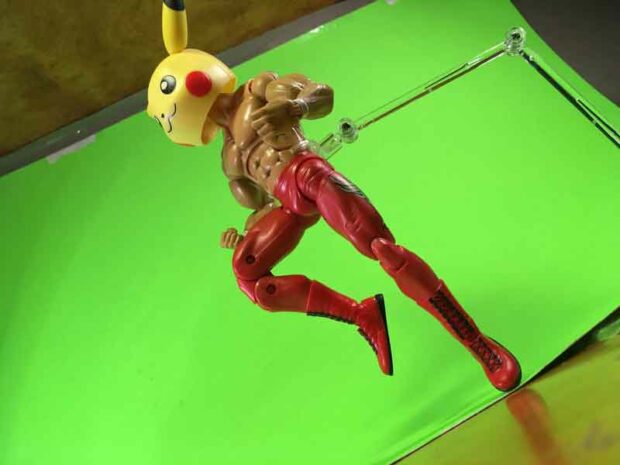
I almost never draw storyboards for my action scenes. Stop motion is a physical medium, so things don’t always go as planned, and that means that my storyboards end up redundant anyway. I find that it’s much more organic and engaging to just keep up with the characters as they move around. I always have ideas in my head, but it’s up to the characters to show me how I’ll get there.
Some ideas stick in my head for years before I ever get a chance to animate them. I even have some old photos from when I first made Pexachu where you can see that I had a few of these moves in mind from the very beginning– specifically, the moves involving beating up Godzilla with a building, and spinning him around by the tail.
(Spoiler Alert) One of the best moments in “Pexachu VS Godzilla” is when Pexachu rips off his underwear and uses it to help defeat Godzilla. It’s hilarious. Where did you come up with the idea? Also, what exactly is “Pexachu”?
Not even I know what Pexachu is, or the extent of his power. All I can say for sure, is that he is a godly being with the body of an Olympian athlete and the head of Pikachu. He is indestructible and unknowable.
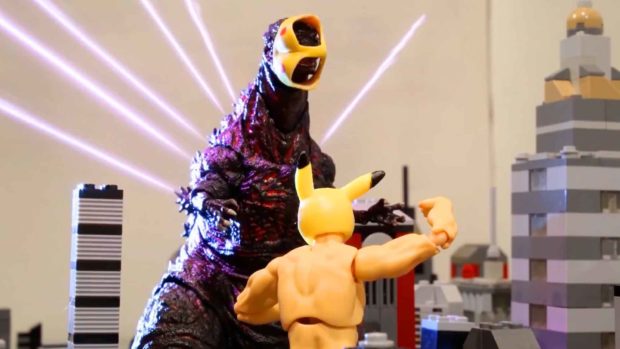
That underwear idea was actually a happy accident, as(Amazon link) Bob Ross might say. I mentioned earlier that I had to buy a second figure for Pexachu’s body when one of the wrists on the original snapped. That particular figure, the(Amazon link) Max Factory Figma Archetype, is designed with a hollow pelvis that contains a Y-shaped balljoint to accommodate his waist and hips.
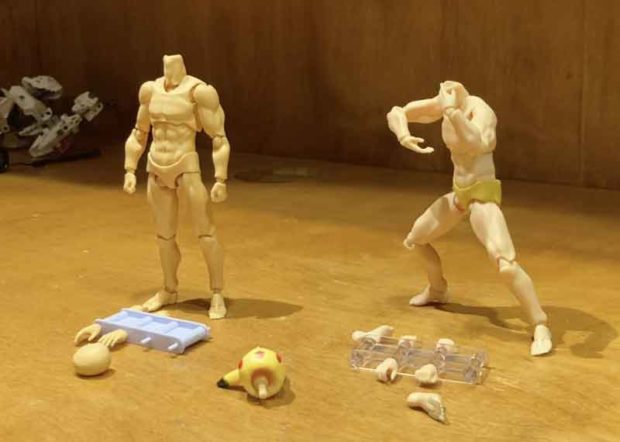
I decided I needn’t bother painting the second pelvis piece, as I already had one finished, so I could just pull off the new figure’s legs and swap it out. But then I realized that I had a spare flesh-tone pelvis, and that meant he could be naked. Once that occurred to me, I knew it was inevitable.
As a kid, were you a fan of both Pokémon and Godzilla?
I enjoyed the original Pokémon anime, and I played the Fire Red game many years ago, but otherwise, I was never that into Pokémon, or any turn-based RPGs, or trading-card games in general. I was always very fond of the character designs, though.
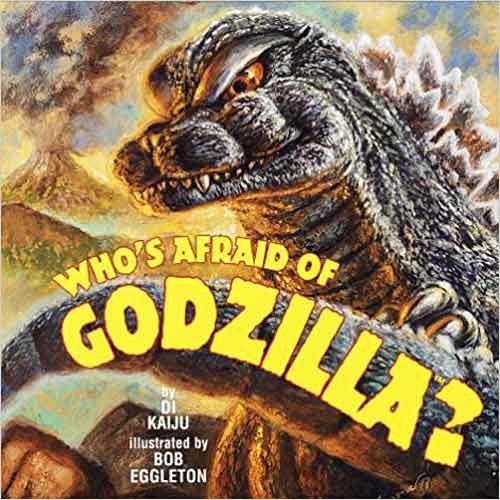
On the other hand, I have loved Godzilla my whole life. I first discovered Godzilla when I found the picture book “Who’s Afraid of Godzilla?” in a thrift shop when I was barely old enough to even read it. I also remember taking weeks to save up fifteen dollars so I could buy a giant Godzilla toy in a vintage store in my old neighborhood. It was a bit harder to find any Godzilla-related products in America in the early 2000s, and I didn’t know much about the Internet, so most of my encounters with him were by pure chance.
The only action figures of him I’d ever seen were hollow vinyl models with four or five points of articulation total, so when I first saw elbows and knees an action figure made by NECA in 2014, my jaw dropped. And then I discovered SH Monsterarts, the best-articulated kaiju action figure line– even the tongues are on a hinge– and my wallet has never been the same.
What software did you use to create this stop motion video?
To shoot stop motion footage, I use Dragonframe, which is the industry-standard software. I used to use Motion for my special effects before upgrading to Adobe After Effects. I do most of my timing and audio editing in Adobe Premiere, and for some effects, like erasing flying rigs, I use Adobe Photoshop.
What about hardware? What is your favorite stop motion camera to use on these projects?
Other than cameras, stop motion hardware is a bit of an arcane topic, as it’s such an unusual medium that most of the hardware is custom-made or DIY’d into existence.
For instance, I have a few flying rigs made from Bionicle LEGO joints, and I use blu-tack to keep action figures’ feet stuck to the ground. Most of my lighting is achieved with adjustable desk lamps, and if I need some color, I use pieces of plastic baggies with colored(Amazon link) Sharpie marker ink scribbled on them.
I originally used a few different Logitech webcams, but eventually, I upgraded to a(Amazon link) Canon EOS Rebel T6. However, its fatal flaw is that it runs exclusively on battery power. Many of my shots would be interrupted when I had to stop and swap out the battery for my spare, which really hurt my momentum, and you can even see the camera shift slightly here and there in still shots. Recently, I replaced it with a(Amazon link) Canon EOS SL3, which can run indefinitely on AC power, and the difference it makes is incredible.
Tell us about your first stop motion video. How did you get into stop motion?
My first-ever stop motion video, back in 2011, was a short claymation animation in which a clay man builds some LEGO structures and then explodes. It was very rough– only 6 frames per second, while Pexachu is 12 FPS and most professional animation is 24 FPS – but the presence of Lego parts and an explosion were very indicative of my future body of work.
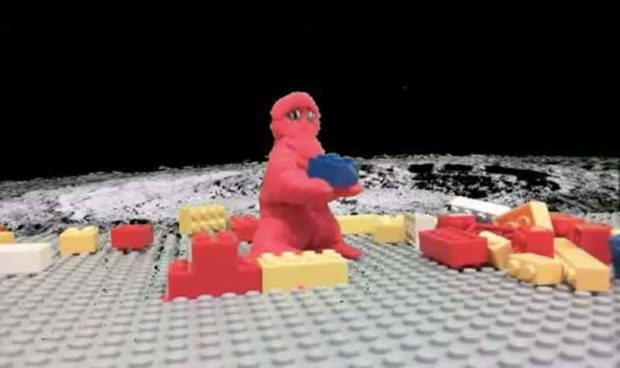
My first experience with stop motion was at a week-long nerd camp. I could choose to learn about video game design, LEGO Mindstorms, or stop motion. I tried game design on the first day, stop motion on the second day, stop motion on the third day, and stop motion on the next few thousand days.
At nerd camp: “I tried game design on the first day, stop motion on the second day, stop motion on the third day, and stop motion on the next few thousand days.”
Charlie Rose, MooXProductions
Who are some of the people who inspired you to make stop motion your artistic medium of choice?
First of all, I have my grandparents to thank for this, as the nerd camp attendance fee was a gift from them. Also, my parents were always very supportive of it as an artistic outlet. But one of my high school teachers, Mr. Caldwell, taught me a lot about digital art and helped me learn all sorts of new skills that I could apply to animation.
When I was a kid, my best friends and I spent most of our time together making “comedy” sketches with a simple digital camcorder and Windows Movie Maker. I think that was the start of my interest in the medium of film in general. We all still talk regularly, and both of them helped me out with my Pokemon vs Godzilla project in a few ways.
I also started to watch Tim Burton’s(Amazon link) stop motion films a year or two into my life as an animator, and that opened my eyes to how far this medium could go. The fight scenes animated by the late Monty Oum in his film Haloid and a few seasons of Red VS Blue were a huge inspiration for my love of action, to the point where it’s possible to find moves in my films that I subconsciously lifted from his work.
And if I had to pick a director whose style helped to inspire mine, I’d say Hideaki Anno, the director of Neon Genesis Evangelion and Shin Godzilla. He’s famous for directing animation in a style that resembles live-action editing, and that’s something that I’m still trying to achieve.
How does stop motion animation fit into your life? Is it your hobby or occupation?
Animation started out as a hobby, but during high school, I realized that I was getting pretty good at it, and I even started to make some money from my stop motion videos on YouTube. I think I finally made the decision during my senior year, when it was time to start looking at colleges, and I focused on getting into art school. Now that I have my bachelor’s degree in animation, I’m working on turning this into a full-time career.
How hard is it to make stop motion animation a career? Is it possible to make enough money from Patreon, YouTube ads, and other miscellaneous revenue sources, or should stop motion animators just go work for a studio to make it all worthwhile?
Unfortunately, I have to admit it’s quite difficult. It’s taken me nine slow years to get where I am now. As an animator, your options are either working in a studio or freelance work. It’s hard to get into a studio, as stop motion is such a slow process, so the turnover rate is quite low. Freelance work is less consistent but much easier to find, and it’s definitely possible to earn a comfortable living by taking commissions from clients.
As for YouTube, though, that’s much harder. YouTube’s algorithm is more likely to promote creators who frequently upload long videos, which isn’t really possible for any form of animation unless you also put up a fair bit of behind-the-scenes content, which is something I’ve started doing lately as well.
It’s absolutely possible, so I don’t want to discourage anyone, but it takes a long time to build up enough of a following to live on ad revenue and Patreon supporters. I absolutely acknowledge that many people aren’t able to invest that much time into something that might pay off someday, rather than just finding other work that pays consistently right from the start.
What advice would you give to someone who wants to get into stop motion? Where and how should they get started?
- The first thing I always recommend is looking up the 12 Principles of Animation. While they were written with 2D animation in mind, almost all of them apply directly to every form of animation.
- Professional cameras and software are expensive, so I suggest looking into some mobile apps like Stop Motion Studio first.
- Use blu-tack to stick down the characters’ feet.
- Get a tripod for your camera or a stand for your phone.
- Never shoot in natural light.
- Always, always, always put your name in the corner of the video, or else someone will steal it and upload it to iFunny and get over a million views. Those views are great but no one will know who made it so you have to make an account and reply to as many comments as you can with a link to your channel.
- And of course, practice constantly. There is absolutely no replacement for experience.
Pexachu VS Godzilla has a great soundtrack and fits perfectly with your animation. Who created the music and did they compose it just for “Pexachu VS Godzilla”?
The soundtrack for Pexachu VS Godzilla is a song called Any Last Words. It was composed specifically for this film by one of my best friends mentioned earlier, Harper Abigail. She got a few of her friends to perform saxophone and upright bass, and digitally engineered the instruments for which she didn’t have a performance. I also brought on another one of my close friends to play the piano part and do a little improvisation to kick some extra life into it.
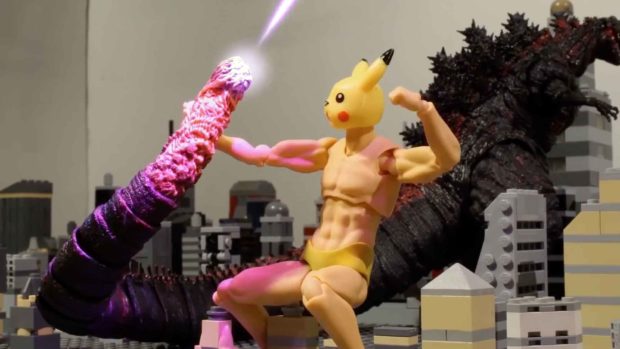
Originally, I was using the opening theme song from Cowboy Bebop as a placeholder track. And by some divine happenstance, the timing of the music matched up flawlessly with the action in my stop motion animation. I was heartbroken when I realized I couldn’t use it in the final version of Pexachu VS Godzilla, as the YouTube copyright gods would strike me down without mercy.
But when I heard the first few versions of Any Last Words, all of my doubts evaporated. If you want to hear more of Harper’s work, you can subscribe to her YouTube channel. She’s already uploaded Any Last Words, as well as In The Pocket, an acoustic western-style guitar song for a previous video of mine called Gun Tricks.
What’s next? Are you going to take a break or are you already working on your next stop motion animation project?
I can’t even remember the last time I took a break. Every time I finish a film, I’m already in the middle of another long-term project, as well as coming up with ideas for shorter videos.
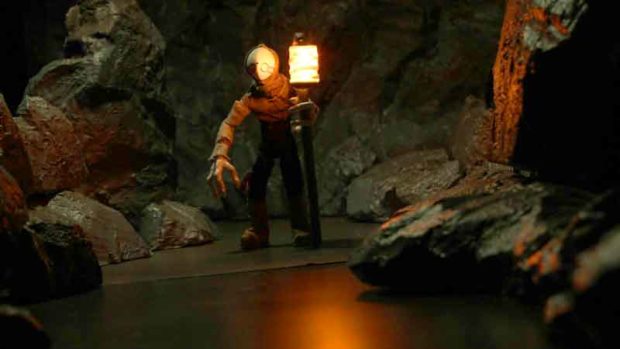
I even have another finished video ready to go in a couple of weeks, and I’m getting very close to completing my thesis film, The Sky Below, which will be the most professional and artistic thing I’ve ever made. And I know my fans will be pleased to hear that I’m working on pre-production for the finale of The Last Colony series.
Tell us something that your friends and family reading this right now don’t already know.
Even though I’m absolutely abysmal at keeping in touch, I love and admire every single one of them.
We end every MethodShop interview with this question. Finish this sentence: “I want everyone reading this to….”
… pressure your state representatives and local government to take radical action on climate change. And wear a gosh darn mask, you simpletons.
You can learn more about Charlie Rose and his animation studio MootroidXproductions at his YouTube channel, Facebook, Instagram, Twitter, and if you’re feeling generous, please support him on Patreon.

Frank Wilson is a retired teacher with over 30 years of combined experience in the education, small business technology, and real estate business. He now blogs as a hobby and spends most days tinkering with old computers. Wilson is passionate about tech, enjoys fishing, and loves drinking beer.

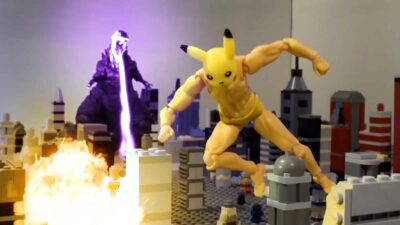
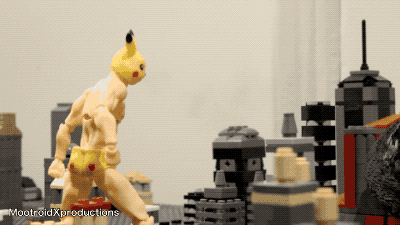










 Insane Thomas The Train Stunts That Both Kids And Parents Will Enjoy
Insane Thomas The Train Stunts That Both Kids And Parents Will Enjoy
Leave a Reply
You must be logged in to post a comment.